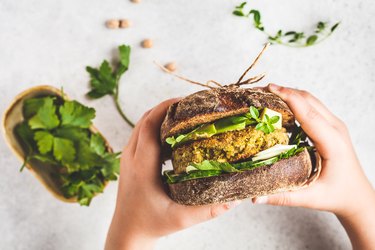
If you've been doing all you can to lose weight, you may be lacking one important nutrient: fiber. Guidelines around fiber can be, at the very least, confusing, and many popular diets (looking at you, low-carb) come up short.
So, how much fiber you need? Roughly 14 grams for every 1,000 calories you're eating, according to the 2015-2020 Dietary Guidelines for Americans. For most people, that comes out to between 25 and 38 grams a day.
Video of the Day
Video of the Day
Still, you may want to aim higher. A February 2015 study in the Annals of Internal Medicine found that simply aiming to eat 30 grams of fiber each day can help you lose weight as effectively as a more complicated diet.
Many foods high in fiber are also low in calories, which can help you fill up without worrying about pushing the limits of your daily calorie intake. Check out these foods that offer the best of both worlds.
1. Chickpeas
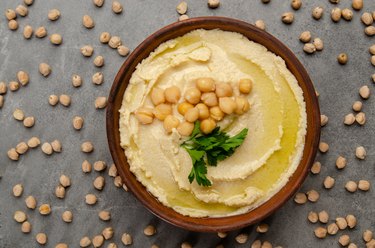
- Calories (per half cup): 134
- Fiber: 6.2 grams
This one is a no-brainer. Beans are high in fiber, so you can't go wrong with garbanzos, aka chickpeas.
Chickpeas are the perfect addition to your diet not only because of their stellar health benefits, but also because of their versatility in recipes. You can add them to salads straight from the can, cook them up in your favorite curry, blend them into hummus and even roast them crispy for a snack.
Choose just one of these ways to eat chickpeas every day and you'll get 16 to 25 percent of your daily fiber, per the USDA.
Chickpeas are a nutrient-dense food, which means they have more vitamins and minerals relative to their number of calories; in other words, they're low in calories, with high nutritional value. Survey research indicates that people who regularly consume chickpeas or hummus are 53 percent less likely to have obesity, according to a December 2016 Nutrients review.
Chickpeas in general have a low glycemic index — the measure of how quickly a food will raise your blood sugar — and hummus's is even lower. Typically, foods low on the glycemic index are higher in fiber and fat and are absorbed and digested slower, which helps keep you full, so you're less likely to overeat, according to August 2020 research in Nutrition. This study indicates that because snacking can make up almost 24 percent of your daily calories, choosing a chickpea-based snack is a smart option.
2. Pears
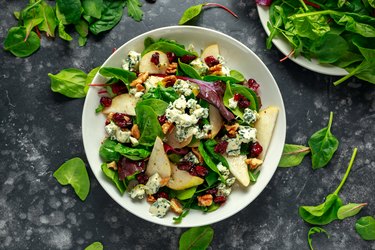
- Calories (1 medium): 101
- Fiber: 5.5 grams
A pear might not be the obvious choice when it comes to high-fiber foods, but 5.5 grams for a medium-size piece of fruit is nothing to ignore — that's more than what's found in your standard apple.
Pears are rich in antioxidants and full of water, which can help keep you hydrated and feeling full. Eating H2O-rich foods has been found to contribute greatly to water intake overall and may have a positive effect on body composition, according to an August 2019 study in Nutrients. In fact, this research indicates that simply staying hydrated may be useful when working to lose or manage your weight.
We often confuse feelings of hunger with feelings of thirst. In other words, you might actually be thirsty when you think you're hungry. If you're not sure, reaching for a water-filled fruit, like a pear, may hit the spot and keep you away from higher-calorie snacks that can hinder your weight-loss goals.
Try adding pears to salads, bake them into a crisp dessert or just enjoy them raw.
3. Raspberries
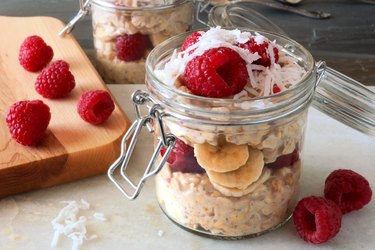
- Calories (1 cup): 64 calories
- Fiber: 8 grams
You want high fiber and low calories? You've got it. Raspberries are a smart staple for anyone on a weight-loss journey. They boast an impressive amount of fiber for an otherwise unassuming fruit.
Eating fruit has long been associated with maintaining a healthy weight. While fruit is full of simple sugars (not added sugars, which are another story), it has an anti-obesity effect and is highly recommended for those actively engaged in weight loss, per October 2016 research in Nutrients.
Raspberries' blend of anti-inflammatory antioxidants, high water content and high fiber content makes them a great fruit pick. You can enjoy them raw, blend them into smoothies (fresh or frozen) or use them to top your favorite oatmeal for even more fiber.
4. Air-Popped Popcorn
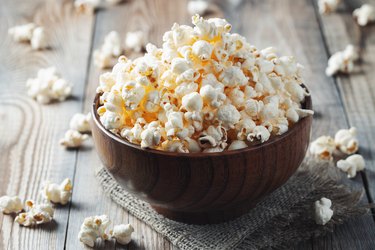
- Calories (4 cups): 122
- Fiber: 4.8 grams
Be careful not to confuse the health benefits of air-popped popcorn with the indulgence of movie theater popcorn — the two are not interchangeable when it comes to your health. Popcorn is innately a healthy choice for snacking when nothing is added to it.
Air-popped popcorn is a good choice for weight loss because it contains a ton of volume per serving, which will keep you full for a longer period of time.
You don't have to eat it totally plain, though. Spritz your popcorn with a little olive oil and make use of your spice cabinet. Dill and garlic, chili and lime or rosemary and basil are all combinations that can make your plain popcorn into a delightful treat without adding a lot of extra calories.
5. Oranges
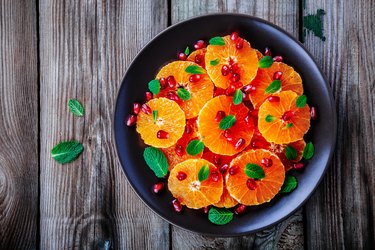
- Calories (1 medium): 69
- Fiber: 3.6 grams
Oranges prove that eating the whole fruit is usually better than just drinking the juice — the fiber is in the pulp of the orange, so best to eat it whole. One medium orange has slightly more fiber than a banana, which could, perhaps, dictate your a.m. fruit choice.
Oranges are a great option to get your fiber in anytime of day. They don't require refrigeration and are incredibly portable, making them an ideal on-the-go snack. Getting an extra 3 to 4 grams of fiber through a snack is a smart way to reach your fiber goals.
An October 2019 study in Nutrition found that increasing fiber intake — independently of macronutrient and caloric intake — was associated with weight loss in 345 overweight adults who consumed a calorie-restricted diet. This finding suggests that one small dietary change — increasing your fiber — has the potential to support weight loss.
Oranges are naturally made for snacking with their perfectly portioned segments. They can also be cut up and added to just about anything, including oatmeal, salads and even dishes like roasted Brussels sprouts or fennel.
3 Tips for Increasing Fiber In Your Diet
By this point, you might be convinced to add some or all of these foods to your diet to increase your fiber in a major way. Before you go blazing down the fiber trail, though, there are a few things you need to know about increasing your fiber.
- Go slow: Increase your fiber slowly, rather than drastically, to save yourself some gastrointestinal upset (think: constipation).
- Drink water: When you increase your fiber, you also need to make sure you're drinking enough water to pass all of that fiber through your digestive system.
- Always choose food sources of fiber first: Sure, you could stir some fiber into your coffee, but you won't get all of the other amazing nutrients from fiber-rich foods. Always choose food first and speak with your doctor if you think a fiber supplement would be a better option for you.
- Institute of Medicine: "Dietary Reference Intakes"
- Nutrients: "The Nutritional Value and Health Benefits of Chickpeas and Hummus"
- Oregon State University Extension:"Glycemic Index and Glycemic Loads for 100+ Foods"
- The Journal of Nutrition: "An Afternoon Hummus Snack Affects Diet Quality, Appetite, and Glycemic Control in Healthy Adults"
- Nutrition Today: "Systematic Review of Pears and Health"
- Nutrients: "Paradoxical Effects of Fruit on Obesity"
- The Journal of Nutrition: "Fiber Intake Predicts Weight Loss and Dietary Adherence in Adults Consuming Calorie-Restricted Diets: The POUNDS Lost (Preventing Overweight Using Novel Dietary Strategies) Study"
- Annals of Internal Medicine: "Single-Component Versus Multicomponent Dietary Goals for the Metabolic Syndrome"
- My Food Data: "Chickpeas"
- My Food Data: "Pears"
- My Food Data: Raspberries
- My Food Data: "Air-Popped Popcorn"